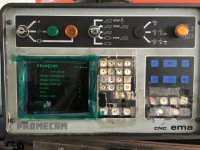I just purchased a 1988 Amada Promecam ITP2 125 Ton X 10' 4 Axis press brake with almost no knowledge of press brakes (I know, poor choice, but I figured I could figure it out like I have with everything else). The CNC portion of the machine is ancient and not in the greatest of conditions, I didn't really consider it an issue because the seller told me it was in working condition. When we got the brake and converted it to our shops power (system (machine - 660V 3PH, shop - 230V 1PH with Phase Converter) the controller was unresponsive, it would randomly flash symbols and static. After a couple of "taps" to the controller it started working properly and I was able to enter the parameters. One problem after another just kept popping up but as of today the back gauge works perfectly but the pump won't start for some reason (even though it did work for me before). I have called Amada for some sort of assistance but the best I got from them was an old manual that wasn't even for my brake. I don't where to start and I got a little over my head on this, so here are the questions:
1. Can the CNC be salvaged? Should I just say screw and see if I can find some sort of conversion kit? And if so, where should I start?
2. If it can be salvaged, who can I talk to about repairs? I'm located in Phoenix, AZ and as best as I can tell this machine was made in France so I'm not really sure where to begin looking for an expert.
3. I'm hoping to use this machine for my current business making HVAC ductwork and roof flashing. What kind of tooling should I be looking for? I usually work with 10' 24GA Galvanized Steel, 8' 16GA Black Iron, and 18GA Galvanized Steel for roof curbs. The bends can very from only a 10º to nearly 130º, and I'm hoping I can get one set of tools (though I'm sure I'm asking for too much).
Any help I can get you guys can give me would be very much appreciated. I've been doing this since I was 17 and after 13 years I still feel like I know nothing about my industry. Thanks for listening everyone!



1. Can the CNC be salvaged? Should I just say screw and see if I can find some sort of conversion kit? And if so, where should I start?
2. If it can be salvaged, who can I talk to about repairs? I'm located in Phoenix, AZ and as best as I can tell this machine was made in France so I'm not really sure where to begin looking for an expert.
3. I'm hoping to use this machine for my current business making HVAC ductwork and roof flashing. What kind of tooling should I be looking for? I usually work with 10' 24GA Galvanized Steel, 8' 16GA Black Iron, and 18GA Galvanized Steel for roof curbs. The bends can very from only a 10º to nearly 130º, and I'm hoping I can get one set of tools (though I'm sure I'm asking for too much).
Any help I can get you guys can give me would be very much appreciated. I've been doing this since I was 17 and after 13 years I still feel like I know nothing about my industry. Thanks for listening everyone!













